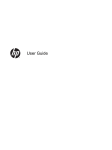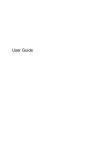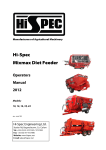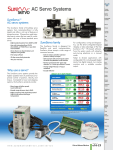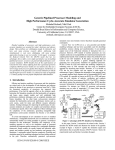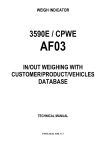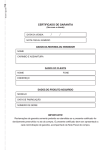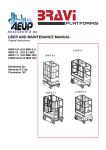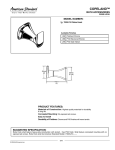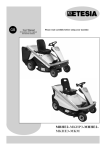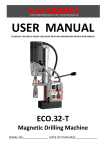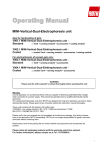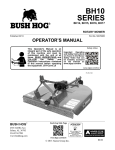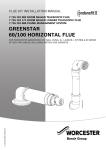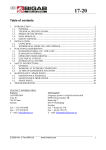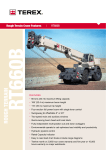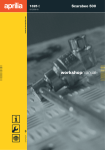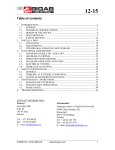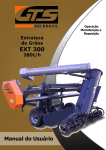Download HL250T users manual
Transcript
www.stronga.com STRONGA MODELLE HL180T HL250T CONTENTS INTRODUCTION..............................................................3 6.8. OBSERVING THE VICINITY DURING LOADING, UNLOADING OR TIPPING.......................................18 1.1 HOW TO USE THIS MANUAL............................3 1.2 INTENDED USE OF HOOKLOADA TRAILER....4 1.3 HOOK TYPES.....................................................4 1.4 HOOKLOADA TRAILER MODELS......................5 OPERATION AND USE..................................................19 7. OPERATION AND USE GENERAL.....................19 7.1 REMOTE CONTROL HANDSET .......................20 7.2. LOADING A CONTAINER.................................21 7.2. LOADING A CONTAINER.................................22 7.3. UNLOADING A CONTAINER............................26 7.4. LOADING OR UNLOADING LONG BODIES WITH A HEAVY LOAD IN THE BACK......................29 7.5. TIPPING A CONTAINER...................................29 7.6. ATTACHING THE TRAILER..............................32 7.7. DETACHING THE TRAILER.............................33 7.8. HYDRAULIC BRAKES OPERATING PROCEDURES.....................................................................34 7.8. BRAKE MAINTENANCE PROCEDURES.........35 7.9. HYDRAULIC CONTAINER DOOR OPERATION ..................................................................................36 PRODUCT DESCRIPTION..............................................6 2. PRODUCT DESCRIPTION...................................6 2.1. MAIN COMPONENTS.......................................6 2.2. PRODUCT IDENTIFICATION............................7 SAFETY INSTRUCTIONS AND REGULATIONS............8 3.1. SAFETY DECALS ON THE TRAILER................8 3.2. SAFETY DECALS LOCATIONS ON THE TRAILER..............................................................................8 3.3. SAFETY DECALS .............................................9 SAFETY DURING USE, GENERAL..............................11 BEFORE DRIVING AWAY..............................................37 4.1. CONDITION OF THE GROUND......................11 4.2. RECOMMENDED SAFETY PRECAUTIONS FOR THE WORKING AREA....................................11 4.3. SAFETY DISTANCES......................................12 4.4. SAFETY FACILITIES OF THE HOOKLIFT EQUIPMENT...........................................................13 4.5. PARKING BRAKE............................................13 4.6. WHEEL CHOCKS.............................................14 4.7. SAFETY INSTRUCTIONS AND MAINTENANCE .................................................................................14 4.9. OFFLOADING FRAME LOCK..........................15 8. BEFORE DRIVING AWAY...................................37 CONTAINERS.................................................................38 9. CONTAINERS......................................................38 PERIODIC INSPECTION AND MAINTENANCE............39 10.1. WEEKLY INSPECTION AND MAINTENANCE BY THE OPERATOR................................................39 10.2. MONTHLY MAINTENANCE BY THE OPERATOR..........................................................................39 10.3. ANNUAL MAINTENANCE..............................39 10.4. SPRING MAINTENANCE................................39 10.5. BEARING MAINTENANCE.............................39 10.7. TIGHTENING OF WHEEL NUTS....................40 10.6. HYDRAULIC SYSTEM MAINTENANCE.........40 10.8. TYRES MAINTENANCE..................................41 10.9. LUBRICATION SUMMARY ...........................42 10.10. CONTROL VALVES *(where fitted)...............43 SAFETY WHEN LOADING AND UNLOADING CONTAINERS........................................................................16 5.1. PICKING UP A CONTAINER...........................16 5.2. MECHANICAL LOCKING.................................16 5.3 HYDRAULIC CONTAINER LOCKING CLAMPS .................................................................................16 5.4 LOADING AND UNLOADING THE CONTAINER .................................................................................17 5.5. CONTAINER FROZEN IN PLACE...................17 TROUBLESHOOTING....................................................44 SAFETY WHEN LOADING, UNLOADING TIPPING....17 6.1. REVERSING THE TRACTOR..........................17 6.2. HOOKLIFT SYSTEM WITH SPRUNG SUSPENSION........................................................................17 6.3. HOOK LIFT SYSTEM WITH AIR SUSPENSION *(where fitted)..........................................................17 6.4. HOOK LIFT TRAILER AND CONTAINER ARE NOT IN ONE LINE...................................................17 6.5. OBSTACLES IN FRONT OF THE CONTAINER .................................................................................17 6.6. PICKING UP THE CONTAINER.......................17 6.7. CHECKING THE CONTAINER GUIDE ROLLERS.........................................................................17 PERSONAL NOTES.......................................................47 1 Operator’s manual ver 3 INTRODUCTION Your purchase of a Hookloada trailer means you now possess a flexible container handling system built on years of development Provided the operating instructions are followed this machine will give years of safe and reliable service. This system is in use all over the world in organisations from building and construction to military, transport and recycling sectors No part of this manual may be reproduced, copied or published without prior permission in writing by Stronga Ltd SECTION 1 Take time to understand the operation of the machine and this manual, practice with an empty container and ensure the operator is fully competent and familiar with the safe operation before starting work. Even experienced operators must learn now to safely operate the Hookloada trailer and pay extra attention to safety decals and instructions contained in this manual. This manual makes clear what you must do and not do. Should a problem arise with the operation of your trailer please contact one of the Stronga service dealers. If you require spare parts please contact your dealer quoting the trailer model number and serial number. WARNING Risk of injury to yourself or others, danger of serious damage to the trailer or other equipment. Follow the instructions. 1.1 HOW TO USE THIS MANUAL The persons operating the trailers and those responsible for its safe operation and maintenance should observe the instructions contained within this manual. Using the trailer correctly ensures the equipment is safe to operate and correct maintenance will allow the trailer to be reliable for years DANGER Risk of serious injury or death. Follow instructions carefully. Do not operate this equipment if - under the influence of drugs, medicine or alcohol. - you are tired or sick. Fatal accidents or serious damage may occur if you have not read, understood or followed the instructions in this manual. HookLoada HLT180 HLT250, This manual is to be used for the above Hookloada models. The operators must become familiar with the control of the trailer without a container. The new operator needs to be trained by an experienced operator by using the empty trailer though it’s loading, unloading and tipping cycles. The safety features and operating components of the trailer need to be explained together with the control functions. 2 Operator’s manual ver 3 INTRODUCTION SECTION 1 1.2 INTENDED USE OF HOOKLOADA TRAILER The Hookloada trailer has been designed for the loading, unloading and tipping of CHEM standard containers. Every other use of the Hookloada trailer is forbidden and Stronga Ltd accepts no responsibility for such other use. Only use the equipment for the purpose to which it was designed and when the equipment is in good condition. DO NOT operate the equipment beyond its stated load limits. 1.3 HOOK TYPES According to your region your trailer may have a different type of hook. The two distinctive hook types are: CHEM standard (1.3.1): Normally found on UK machines and is designed to pick up CHEM standard containers DIN standard(1.3.2): Normally found on European machines and will pick up DIN standard containers 1.3.1CHEM hook 1.3.2 DIN hook 3 Operator’s manual ver 3 INTRODUCTION SECTION 1 1.4 HOOKLOADA TRAILER MODELS This manual covers the following trailer types: -Model Telescopic HLT180 -Model Telescopic HLT250 C,D and S range trailers HookLoada HLT180 Hookloada HLT 250 4 Operator’s manual ver 3 PRODUCT DESCRIPTION SECTION 2 2. PRODUCT DESCRIPTION The HookLoada hook lift system is capable of loading containers, transporting, tipping and unloading them. Operation of the main cylinders will execute the tipping cycle or hook/off-hook cycle. The trailer has two pivot points, one at the back of the front frame and the second at the back of the rear frame. The main cylinders when operated will try to force the trailer to fold at the front frame or the rear frame. Which frame folds is dictated by the position of the following components; 1] The telescopic hook tower - forward or back 2] The container locking clamps - open or shut 2.1. MAIN COMPONENTS A Gripping hook B Hook tower C Tower cylinder [hidden in tower frame] D Tower frame ETrailer chassis / main frame F Main cylinders G Front Frame H Rear Frame I Middle locks / C Hooks J Rear axle stabiliser cylinders / Stabjacks K Container locking clamps L Rear rollers 5 Operator’s manual ver 3 PRODUCT DESCRIPTION SECTION 2 2.2. PRODUCT IDENTIFICATION The manufacturer’s plate is located at the front of the trailer on the main chassis. Key information is engraved on the plate in the following sequence. 1 2 3 1. Model number 2. Serial number 3. Year of manufacture 4. Total weight of trailer, container and payload 5. Maximum hooking load including container 6. Maximum tipping load including container 7. Total weight across all axles 8. Maximum load on drawbar 4 5 6 7 8 6 Operator’s manual ver 3 SAFETY INSTRUCTIONS AND REGULATIONS SECTION 3 3.3. SAFETY DECALS HL 3.2. WORKING AREA DO: Stay clear of the working area when tipping, loading or unloading the container. DO NOT: Stand close to, in front of or behind the trailer during operation. LOCATION : Each side at the rear of the trailer. HL 3.2 HL 3.3 STAY CLEAR UN-PROPPED BODY DECAL DO: Keep clear of body during loading/unloading and tipping. DO NOT: Work or stand near trailer during operation. LOCATION : Front of the trailer both sides. HL 3.3 HL 3.4. CRUSH ZONE DECAL DO: Stay outside the area between trailer and tractor while machine is operating. DO NOT: Enter the zone between trailer and tractor until tractor engine is stopped and the tractor parking brake is applied. LOCATION : This decal is located on the front left side of the trailer. 8 Operator’s manual ver 3 SAFETY INSTRUCTIONS AND REGULATIONS SECTION 3 HL 3.5. BEWARE OF OVERHEAD WIRES DO: Stay clear of overhead wires and cables. Take particular care when tipping the container. DO NOT: Operate the trailer within 6 metres of overhead cables. LOCATION : This decal is located on the front right side of the trailer. HL3.6. ENSURE WHEEL NUTS ARE KEPT TIGHT DO: After 40 - 50 km of use check wheel nuts and ensure they are tightened. Also check all U Bolts and other bolts on the trailer. DO NOT: Over tighten bolts. LOCATION : This decal is located on the front right side of the trailer. HL3.7. READ AND UNDERSTAND OPERATOR’S MANUAL WARNING : Before operating read and understand user’s manual LOCATION: This decal is located on the front left side of the trailer and near auxiliary couplings*(where fitted) DANGER If you have not studied the Operator’s manual for your hooklift equipment carefully, this may lead to fatal accidents or serious damage. Ensure that you meet the statutory health and safety regulations/requirements of the country 9 Operator’s manual ver 3 SAFETY DURING USE, GENERAL SECTION 4 The driver must be familiar with the contents of this manual and should follow the directions and instructions strictly. He must ensure that the trailer is in good working order prior to use. Before using the trailer the operator must satisfy himself that the operation being undertaken is safe and that all potential risks are assessed. The operator must also take into account the environment in which the trailer will be operating. 4.1. CONDITION OF THE GROUND Before you start loading or unloading with the HookLoada hooklift equipment you must inspect the following: - The ground must be firm and free from potholes that the trailer may move into during operation of the hooklift. - The ground must not be slippery. - The ground must be level. 4.2. RECOMMENDED SAFETY PRECAUTIONS FOR THE WORKING AREA - Check the vicinity for possible dangers. When unloading, the container must be lowered in line with the the trailer first. If working in the dark: the use of rear facing work lghts is recommended. DANGER! 4.2.Risk of injury. It is the responsibility of the driver to ensure that there are or will be no persons within the danger zone of the working area. DANGER! It is strictly forbidden to stay within the area between the container and the chassis of the trailer 4.3.Risk of injury. 10 Operator’s manual ver 3 SAFETY DURING USE, GENERAL SECTION 4 4.3. SAFETY DISTANCES D A B C 4.3.1. Safety distances. DANGER ZONE SAFETY DISTANCE Front of the tractorA Full length of the tractor and trailer Rear of the trailerB Full length of the tractor and trailer + length of the container Left and right of the tractor and trailerC At least 10 meters Above trailerD At least 6 metres above ground 4.3.2. Danger zone and safety distance. 11 Operator’s manual ver 3 SAFETY DURING USE, GENERAL SECTION 4 4.4. SAFETY FEATURES OF THE HOOKLIFT EQUIPMENT 4.4.1 Warning Triangle Situated at the front of the trailer and visible from the tractor cab the warning triangle indicates the relative position of the axle stabilisers and the container locking clamps. Warning Flag UP The axle stabilisers are down locking out the rear axle springs and the container clamps are open Warning Flag DOWN The axle stabilisers are up releasing the rear axle springs and the container clamps are closed. 4.4.1.Safety warning triangle. Driving at speed with the axle stabilisers down could cause the trailer to overturn Driving with a container and the clamps open could cause the container to unseat from the trailer. 4.4.2 Hydraulic Lock Out Valves Located to the side of the container locking clamps is a single acting lock out valves. It is connected inline with the hydraulic circuit that operates the telescopic tower cylinder. When the container clamps are closed the valve is closed preventing movement of the telescopic tower. 4.4.2 Hydraulic Lock Out Valve 4.5. PARKING BRAKE LOCATION: Handbrake is located on the front left side of the trailer. Air Braked trailers may have the manual handbrake as an option or use the Push to Shunt valve when the trailer is stationary. Air b WARNING ONLY use the handbrake when trailer is parked. Maintain the handbrake in good condition. ALWAYS activate the handbrake before disconnecting the trailer from the tractor 4.5.1 Manual Handbrake or Air Braked Push to Shunt Valve 12 Operator’s manual ver 3 SAFETY DURING USE, GENERAL SECTION 4 4.6. WHEEL CHOCKS [ OPTIONAL ] LOCATION: If fitted wheel chocks are located on both sides of the trailer in customer brackets. Release the tab and pull chock from the holder and place on the floor in front of the wheel. WARNING 4.8.1. Wheel chocks on the trailer. Use wheel chocks when trailer is parked. Use wheel chocks when trailer is transported on other vehicles. 4.7. SAFETY INSTRUCTIONS AND MAINTENANCE ATTENTION Always follow the maintenance instructions and use only original HookLoada hook lift trailer spare parts. 13 Operator’s manual ver 3 SAFETY WHEN LOADING AND UNLOADING CONTAINERS SECTION 5 During loading of the trailer the indicated axle load must not be exceeded. Also the hook lift equipment must not be overloaded, (see chapter 12.1. TECHNICAL SPECIFICATIONS) for maximum capacity of the equipment. 5.1. PICKING UP A CONTAINER Before picking up a container check the following: · Gripping height. · Tunnel width and height. · Location of the mechanical locking points on the container and equipment ( see5.2.). · Status of the hydraulic rear container locking clamps (see5.3.). 5.2. MECHANICAL LOCKING Pushing forward the telescopic hook tower fully, mechanically locks a container to the chassis by pulling the container locking pockets under the trailer C Hooks.(where fitted) 5.3 REAR CONTAINER LOCKING CLAMPS 5.2 Telescopic tower fully forward. The C Hooks have engaged locking pockets When closed the container locking clamps lock the container sub frame to the trailer chassis WARNING Be sure that container locking clamps are open before loading or unloading. If the locking clamps are open the warning triangle will show and the hook tower circuit becomes live. 5.4 LOADING AND UNLOADING THE CONTAINER Before loading or unloading check to be sure the load is properly secured and covered. Ensure that the centre of gravity of the load is as low as possible and is as much as possible in the centre of the container, both longitudinally and transversely. If load must be fastened, do this when the container is on the ground. 14 Operator’s manual ver 3 SAFETY WHEN LOADING, UNLOADING TIPPING 5.4 LOADING AND UNLOADING THE CONTAINER 6.3. HOOK LIFT SYSTEM WITH AIR SUSPENSION*(where fitted) Before loading or unloading check to be sure the load is properly secured and covered. Ensure that the centre of gravity of the load is as low as possible and is as much as possible in the centre of the container, both longitudinally and transversely. If load must be fastened, do this when the container is on the ground. 5.5. CONTAINER FROZEN IN PLACE SECTION 5/6 If the hook lift system HookLoada has axles with air suspension, the factory instructions must be followed when tipping, loading or unloading a container. The air suspension must be fully deflated before tipping, loading or unloading. 6.4. HOOK LIFT TRAILER AND CONTAINER ARE NOT IN ONE LINE If the HookLoada trailer is not in line with the conWhen working in low temperatures the container may tainer which is on a hard surface: be frozen to the ground. If the operator attempts to lift Line up the container by lifting the front of the conthe container in this situation the trailer and/or container approximately 10 cm off the ground and puling tainer may be damaged. it forward (see 7.21 and 7.22). This will prevent the container being pulled outside the rear rollers, the If the container is frozen to the ground: rear lights being damaged or the bumper being hit. · Do not attempt to free the container by using the hook lift trailer. Use, for example, a forklift truck. 6.5. OBSTACLES IN FRONT OF THE CONTAINER DANGER In case of emergency : Release tractor spool valve. Stop tractor engine. Apply tractor parking brake. 6.1. REVERSING THE TRACTOR Reverse the tractor as slowly as possible to avoid damaging the container, the load, or the hook lift equipment. 6.2. HOOKLIFT SYSTEM WITH SPRUNG SUSPENSION When moving the container to get in line with the trailer, first remove all obstacles in front of the container. 6.6. PICKING UP THE CONTAINER Before picking up the container, the hookbar of the container must be properly inside the lifting hook. In this way you can prevent the container falling. 6.7. CHECKING THE CONTAINER GUIDE ROLLERS When loading or unloading be sure that the container is running well between rear rollers. When lifting on a loaded container the rear axle and springset will be temporarily overloaded. To prevent damage to the springs ensure that the stabilizing jacks are down in the locked position before lifting loaded containers. 15 Operator’s manual ver 3 SAFETY WHEN LOADING, UNLOADING OR TIPPING SECTION 6 6.8. OBSERVING THE VICINITY DURING LOADING, UNLOADING OR TIPPING While loading, unloading or tipping check the area around the trailer and the movements of the container. When disruptive movements of the container occur, release the spool valve in the tractor and stop the engine. The cause of these movements should be corrected before restarting. 6.8.1.Never load, unload or tip when the load is heavier to one side of the body. WARNING NEVER LOAD, UNLOAD OR TIP WHEN - the load is heavier to one side of the body - On sloping or slippery ground - On soft or crumbly ground under the wheels - During strong side winds - the container and/or load is frozen or stuck - The trailer has weak springs on one side - Tyres are in poor condition - load exceeds trailer capacity 6.8.2.Never load, unload or tip when the ground is sloping CAUTION Each motion must begin and end with tick over speed of the tractor engine. 16 Operator’s manual ver 3 OPERATION AND USE SECTION 7 7. OPERATION AND USE GENERAL When there is no container mounted, the hooklift equipment must be positioned so that all frames are in the seated/transport position both during driving and during parking. Never drive the trailer in any position other than transport position. Take care starting to work with the container, check to be sure that it is suitable for load to be transported. The lifting hook is a vital component to the safe operation of the trailer. The risk of wear of the hook is increased when the container has a heavy load to the rear of the container. The condition/wear of the lifting hook must be checked monthly. WARNING CAUTION If the dimensions of the hook are outside the min./max. Allowed dimensions, the hook must be replaced immediately by an authorized HookLoada dealer. The hook must be replaced if the wear exceeds 10 %. Always use original HookLoada parts. Loading and unloading a container with a heavy load in the back requires extra care, see also 7.4 Be sure that the container has the proper dimensions. First see Chapter9. The condition of the container must be checked regularly. Especially if you are going to use a type of container with which you are not familiar. In particular check the condition of the locking points and the condition/position of the hookbar. Maximum allowed wear of the lifting hookbar: 10 % of the nominal diameter, nominal diameter is 68 mm on CHEM standard containers. The longitudinal chassis rails at the bottom of the container are under a heavy burden. Carry out daily checks of these components for wear or damage. 7.1. HookLoada lifting hook. *(may vary according to region) 17 Operator’s manual ver 3 OPERATION AND USE SECTION 7 7.1 REMOTE CONTROL BOX*(Standard on HLT250 optional on HLT180) PTO hydraulic pump , oil tank and remote control handset are standard on the HLT250 and Optional on the HLT180 Model. Ensure the Tractor power take off drive is disengaged and tractor engine stopped prior to connecting the power shaft Ensure all power take off shaft safety guards are in place. Connect the power shaft to the tractor Connect the 12 volt power 1 Operation The control box will indicate on its face which circuit is live. The operations on the handset are clearly marked. Always use the handset inside the cab of the tractor or in a safe location where you have good visibility of the operation of the equipment 7.1.1. Control box for diverter valve Engage the Power take off to start the flow of oil around the system Use the remote control handset to control the equipment CAUTION Ensure all persons are clear of the power shaft before engaging the drive Do not overload the trailer. Technical data of the trailer must be observed with regard to maximum permissible loading, unloading, tipping and axle load. WARNING Operate hook lift trailer only if you are sitting in the driver’s seat. The Remote Control Handset must be placed in the cabin area where no obstacles or loose objects might accidentally activate a switch. All functions of the control box must be checked before use if the equipment has not been in use for 20 days or longer. Keep the control box dry. 18 Operator’s manual ver 3 OPERATION AND USE SECTION 7 Use slow and precise motions of the tipping cylinders when loading/unloading container with the tractor at tick over. The more the engine speed increases the more the speed of the middle frame increases. On some tractors oil flow can be adjusted. In this case adjust oil flow to give slow and controlled speed of operation. The speed of the tipping cylinders is dependant on the engine speed and oil flow though tractor spool valves. CAUTION The operation of the hooklift must take place in the correct sequence. One operation at a time. CAUTION Use tractor spool valve flow adjuster to control the speed of loading/unloading container. 7.2. LOADING A CONTAINER Before you start, see that the load is well secured and covered. Also ensure that the loads centre of gravity is as low as possible and evenly distributed in the container. If the load must be secured, do this when container is on the ground. Before picking up the container, check the hook and the amount of headroom available correspond with the equipment and that the notches for the rear container locking clamps are in the correct positions (see 5.2. and5.3.). On standard equipped sprung suspension trailers stabilizer jacks must be fully lowered to touch the spring before loading/unloading loaded container. If trailer has air suspension this must be deflated. 7.2.1. Reversing the trailer. CAUTION During the loading operation, the handbrake of the towing vehicle should not be engaged, until the rear side of the body is lifted from the ground. 19 Operator’s manual ver 3 OPERATION AND USE SECTION 7 7.2 Operating the trailer where trailer is Directly plumbed to tractor hydraulic system 1 Reverse the trailer carefully to the container, about 5 metres from the hookbar, ensuring the trailer is in a straight line with the container. 2 Stop the vehicle and engage the handbrake. 3 Operate the hydraulic spool lever to pressurise the clamp and stabilisers hose (tagged yellow and red). This will cause the clamps to open and the the stabiliser jacks to drop down to touch the springs. At the same time the warning triangle pops up to alert the user that the stab jacks are in their lower position. See 7.2.2.Also deflate air suspension fully *(where fitted). 7.2.2. Clamps open, stabjacks down, warning triangle is up. ATTENTION Extend the rear axle stabiliser jacks until the cylinders are fully extended. On trailers with air suspension axles, it is always advisable to fully deflate the air bags. Failure to lock out the rear axle during loading could damage the trailer suspension. 4 Operate the spool valve/remote control control handset for the hook tower to push the tower back ensuring it reaches the end of it’s travel. (see7.2.3) As as the hook tower is pushed back the tower pushes off the frame lock pin to unlock the tipping frame into loading mode.See7.2.5 The hook tower will only operate when the clamps are open due to the safety lock out valve attached to the clamps. 5 7.2.3. Clamps open, stabjacks down, warning triangle is up. (1) (2) 7.2.4. Remote control handset Engage the spool lever/remote control for the main lift rams (green and red marked pipe), to lift the hooking frame up and over (see7.2.4) 20 Operator’s manual ver 3 OPERATION AND USE SECTION 7 and disengage the spool lever/remote control handset button when the hook reaches the same level as the hookbar. (7.2.5) 7.2.4. Main rams pushing loading frame into position. 7.2.5. Align hook to same height as hookbar It is recommended that the container to be loaded should always be in line with the trailer. Where it is not possible the angle of the trailer to the container must not exceed 20 degrees (see7.2.6.). 20 Reverse the trailer back to engage the hook on the hook bar.(7.2.7) The height of the hook may be adjusted if necessary by raising or lowering the main lift rams (green tagged pipes). 7.2.6. Container and trailer are not in line. 7.2.7. Reverse trailer onto hookbar 21 Operator’s manual ver 3 OPERATION AND USE 6 Push the spool lever/remote control handset button in the opposite direction (pipe tagged green and blue) pull the main rams back in thus raising the hook and lifting the container. 7 As the container is raised and begins to pull on the container, gently reverse the trailer under the container this minimises the strain on the container and on the trailer components. 8 Before the container comes into contact with the trailer check to ensure the guide rails of the container are correctly aligned with the rear rollers (see 7.2.8). If the rollers are not in line lower the container to the ground, unhook the hook from the container and re-align the trailer with the container correctly and repeat from step 6. SECTION 7 7.2.8. Ensure rails are aligned with the rollers 9 When the rear rollers are in line with the container rails continue to pull the container on to the trailer. When the frame is approximately 400 mm from the main frame, reduce the oil flow by releasing the lever from it’s detent and feathering the lever, allowing the hooking frame to gently come to rest on the main chassis (see 7.2.9) 7.2.9 Allow the front frame to come to rest on the main chassis 22 Operator’s manual ver 3 OPERATION AND USE 10 Operate the spool/remote control handset for the hook tower (black marked pipe) (first switch to position(2)on control box *(where fitted) to push the tower forward to it’s fully forward position, this pulls the container onto the mid locks on the trailer frame and at the same time the frame locking pin is engaged allowing the trailer to tip (7.2.10.) 11 Finally, move the spool/remote control handset for the clamps and stab jacks (yellow tagged pipe) into the return position this will cause the clamps to lock onto the container (as shown in 7.2.11) and the stab jacks to retract back from the axles. It is recommended that the driver visually checks that the clamps have fully engaged on the container chassis. If the chassis or clamps are damaged report it to the service manager. SECTION 7 7.2.10 Pull the tower frame forward fully to engage C-Hooks Do not operate the trailer if any components are damaged or broken. When the stab jacks have retracted fully the warning triangle at the front of the trailer will drop back down. 12 Re-inflate the air suspension *(where fitted) 13. Once all checks have been completed it is safe to drive off. 7.2.11. Clamps locked onto the container DANGER Before you start driving away make sure that: The container is secure The load is well positioned/covered. The container doors are closed. Axle stabiliser [stabjacks] are fully retracted. The warning flag is not showing The air suspension is raised to ride height (where fitted). 23 Operator’s manual ver 3 OPERATION AND USE SECTION 7 7.3. UNLOADING A CONTAINER 1 Drive the trailer to the place where the container has to be unloaded. 2 Check the working area and ensure there is enough space in front, on the rear side and above the trailer (see7.3.1. safety distance and 4.3.2.danger zone and safety distance). Stop the vehicle and engage the handbrake 3 4 Operate the hydraulic spool lever to pressurise the clamps and stabilisers (yellow hydraulic circuit). This will cause the clamps to open *(where fitted) and the the stabjacks to drop down and lock out the springs. At the same time the warning triangle pops up to alert the user 7.3.1. Safety distance that the stab jacks are in their down position. See 7.3.2. Also deflate air suspension fully *(where fitted). ATTENTION: Extend the rear axle stabiliser until the cylinders are fully extended. On trailers with air suspension axles, it is always advisable to deflate this fully. Always extend the stabiliser fully before picking up containers. Failure to do so could damage the trailer suspension. 5 Operate the spool valve for the hook 7.3.2. Opening of the hydraulic rear container locktower/remote control handset button (pipe ing clamps stab jacks and flag detail. tagged black) to push the tower back ensuring it reaches the end of it’s travel. As soon as the hook tower is pushed to its fully back position the tipping frame is unlocked. (See 7.3.3 ) NOTE: The hook tower will only operate when the clamps are open due to the safety lock out valve attached to the clamps. 7.3.3. Hooktower is fully back unlocking the frame for tipping. 24 Operator’s manual ver 3 OPERATION AND USE 6 Engage the spool lever for the main lift rams (green marked pipe), to lift the hooking frame up and over (see7.3.4). 7 When the rear rollers of the container reach the floor, gently pull the trailer forward to ensure the rear rollers of the container remain stationary. CAUTION SECTION 7 7.3.4. Main rams lifting the container up and over. During the unloading of a heavy container the tractor rear end may lift from the ground. This will happen if the rear axle stabjacks are not down, the air suspension ( optional ) has not been fully deflated or the trailer/tractor combination is not matched. 8 When the front of the container is approximately 500 mm from the floor, knock the spool valve out of it’s detent and gently feather the lever to reduce the flow and thus give a smooth controlled decent. CAUTION Allow the container to drop gently until it is fully on the floor Check that the container is not coming into contact with the bumper. Stop the movement of the middle frame as soon as the container is standing on the ground. If the movement of the hookarm is not stopped in time, the trailer pushes itself from the ground: which will result in a damaged container/trailer or hooklift equipment. 9 Disengage the hook from the hookbar by slowly pulling the trailer forward. The height of the hook 25 Operator’s manual ver 3 OPERATION AND USE SECTION 7 may be adjusted if necessary by raising or lowering the main lift rams (green tagged pipes). Do not adjust the height of the hook by moving the hooktower 10 Stop the vehicle and engage the handbrake. Check the amount of available headroom above the trailer and ensure there is at least 6 m. 11 Operate the spool lever for the main rams (green and blue tag) and pull the loading frame back over and down to rest on the chassis. Reduce the flow, by feathering the spool lever/remote control handset, when the frame is approximately 500 mm from the chassis. 12 Operate the spool for the hook tower/remote control handset button (black and blue tagged pipe) to push the tower back to it’s fully forward position (7.3.8). 13 Operate the spool/remote control handset button for the stabjacks and clamps (yellow and blue tag) until the clamps have closed *(where fitted) and the stab jacks have fully retracted. This will be indicated by the warning flag returning to it’s down position (7.3.9). Inflate air suspension to ride height *(where fitted) 14 7.3.6 Disconnect hook from hookbar 7.3.8. Push the hook tower fully forward 15 The trailer is now in transport position, once all checks have been made it is safe to move off. DANGER Before you start driving away check that Axle stabjacks are fully retracted. The warning flag is not showing The air suspension is raised to ride height (where fitted). 7.3.9. Retracting stab jacks with warning flag detail 26 Operator’s manual ver 3 OPERATION AND USE SECTION 7 7.4. LOADING OR UNLOADING LONG BODIES WITH A HEAVY LOAD IN THE BACK Loading or unloading a long container with the load in the back must be done very carefully. There is a risk that the hookbar can escape from the hook. This can be avoided: 1 When loading: Carefully and slowly operate the main rams to lower the container onto the chassis. Make sure that container locking gripping points do not fall on the mid locks of the equipment. Then pull the hooktower fully forward. 2 When unloading: Carefully push the hooktower back, and operate the main rams slowly and carefully until the back of the container touches the floor. 7.5. TIPPING A CONTAINER 1First check the overhang of the container. The operator must be satisfied that the bottomedge of the container will not hit the ground when tipped. Trailers with air suspension. If the trailer has air suspension, the air suspension must be fully deflated before tipping, loading unloading. WARNING In very cold weather the load may frozen in the container, it must be freed before tipping. Take care that the load might come out in large chunks! 27 Operator’s manual ver 3 OPERATION AND USE SECTION 7 DANGER Never tip under the following circumstances: - the container is top-heavy on the front or on the side; - the load is frozen or partly loosened load; - the ground is slippery or not in level; - strong side winds. 7.5.3.Never tip when the ground is slippery or not in level. WARNING In 7.5.4. The back part of the container will touch the ground when tipping and the container or trailer or hooklift equipment will be damaged. CAUTION 7.5.4.Too much overhang. During tipping the hydraulic rear axle stabiliser must not be activated! If the trailer is fitted with air suspension, air bags must be fully deflated before tipping, loading and unloading. 28 Operator’s manual ver 3 OPERATION AND USE 1 Drive the trailer to the place where the load has to be discharged. Check the work terrain and be sure there is enough space behind and above the trailer/container. Special attention is required for high voltage cables see4.3.2. 2 Switch diverter to main rams (see 4.4.1) *(where fitted). Use the tractor spool valve to tip the trailer (green with blue tag). The hydraulic rear container locking clamps must be locked and the hydraulic rear axle stabiliser must not be activated! The warning flag must be down. 3 Open the tail gate of the container, when doing thisstand to one side of the container! 4 Operate the main cylinders/tower frame combined with the rear frame to the desired or maximum tipping angle. 5 Decrease the speed of the tipping movement to prevent an abrupt stop during the last tipping phase. 6 If necessary drive a few meters forward to unload the complete contents of the container. SECTION 7 7.5.5.Tipping the container. Lowering the container. 1 Ensure the diverter is set to main rams for lowering the container (see 4.4.1)*(where fitted). 2 Operate the the main rams to lower the container using the tractor spool valve (pressurise the pipe tagged green and blue) 3 Check if the equipment is in its lowest position. 4 Close the tail gate. DANGER If it is necessary to drive in tip position, pay attention to the vicinity regarding the height of the hooklift equipment/container with respect to the surroundings like bridges, tunnels and overhead power lines! Drive slowly and be extra careful. 29 Operator’s manual ver 3 OPERATION AND USE SECTION 7 7.6. ATTACHING THE TRAILER Green Owing to the consideration laden weight of the trailer, the hitch is designed for use with a pick up hitch only, and not clevis type drawbars. IIf a selector valve is fitted to the tractor, ensure that for all trailer applications the lever is in the LINKAGE position. Yellow Black Red Blue To lower the hook: 7.6.1. Tractor connections With the draft lever in theUP position, move the position control lever to theCONSTANTPUMPING position. Pull the release lever to disengage the latch mechanism and move the position control lever through the quadrant to theDOWN position, releasing the latch at the same time. Reverse the tractor until the hook is immediately beneath the ring on the trailer drawbar. To raise the hook: With the draft lever in theUP position and the hook positioned directly beneath the trailer drawbar eyelet, move the position control lever through the quadrant to theUP position, ensuring that the hook and eyelet become correctly engaged. Move the position control lever to theCONSTANT PUMPING position until the latch mechanism automatically and audibly engages the catches, then return the control lever to the TRANSPORT position. Attach the hydraulic and electrical services to the tractor hydraulic hose configurations are shown in7.6.1. 7.6.2. Remove skid and attach to skid hanger Remove the skid from under the drawbar and place it in it’s storage position (see7.6.2) For additional information about attaching trailers using pick up hitches see the tractor Operator Instruction Manual. 30 Operator’s manual ver 3 OPERATION AND USE SECTION 7 7.7. DETACHING THE TRAILER Apply the trailer parking brake (see4.7.). Care must be taken to ensure that the multi-stroke brake handle has been operated a sufficient number of times to lock the parking brake. Remove skid from skid carrier and attach to underside of drawbar (7.7.1.). If lighting equipment is fitted the plug to the tractor should be disconnected. Remove the hydraulic hoses from the tractor hydraulic connection and attach the couplings to the storage positions on the trailer chassis. Remove all air hoses (if applicable). 7.7.1. Skid attached to underside of drawbar. It may happen that there is residual back pressure in the system, making it difficult to withdraw the coupling, because the balls are seated under pressure. Should this occur, stop the tractor engine and operate the spool valve lever a few times to relieve the back pressure. With the draft lever in theUP position, move the position control lever to theCONSTANTPUMPING position. Pull the release lever to disengage the latch mechanism, and move the position control lever through the quadrant to theDOWN position, releasing the latch lever the same time. When the hook is completely disengaged from the ring, drive the tractor away from the trailer. Raise the hook by moving the position control lever to theCONSTANT PUMPING position. As soon as the latch mechanism is engaged, return the control lever to theTRANSPORT position. 31 Operator’s manual ver 3 OPERATION AND USE 7.8. HYDRAULIC BRAKES OPERATING PROCEDURES WARNING The operator is strongly advised to consult the appropriate tractorOperator Instruction Manual for detailed instructions on the use of the tractor controls. Before attaching any services, ensure the parking brake is on and the vehicle engine is switched off. Tractor - trailer Hydraulic brakes: 1 2 3 4 3 4 5 2 3 4 5 6 SERIOUS DAMAGE TO THE BRAKING SYSTEM MAY OTHERWISE RESULT. *(where fitted): Check air tank valve is closed. Connect yellow brake line to matched port on tractor. Connect red brake line. Ensure that hydraulic brakes are not connected. Inside tractor cabin: check air pressure reading is sufficient before moving off. When connecting ABS 1 DO NOT ATTACH BOTH AIR AND HYDRAULIC BRAKES Remove the brake hose from the storage position on the trailer. Remove the cap from the hydraulic trailer brake quick release coupling at the rear of the tractor. Fit the hose quick release coupler on to the brake coupling and release the knurled cover to secure it. Latch the tractor brake pedals together. The trailer brakes will operate whenever the tractor brakes are applied. When connecting Air brakes 1 2 SECTION 7 *(where fitted): Connect ABS DIN 72570 lead to tractor and trailer. Depress foot brake Turn ignition on Wait for warning light to flash sequence on-offon Release foot brake Warning light will flash on and off when brakes applied over 10 km/h. When connecting Dual Air/Hydraulic brakes fitted): *(where 1 Connect airOR hydraulic brakes as described above 32 Operator’s manual ver 3 OPERATION AND USE SECTION 7 7.8. BRAKE MAINTENANCE PROCEDURES Brake maintenance should be carried out at appropriate interval according to the conditions. In wet/muddy conditions checks/ maintenance should be more frequent. Adjusting the brakes: Initial brake adjustment for lining wear is made by releasing the lock-nut on the bolt which is directly behind each ram. The bolt should then be turned clockwise until the brake is just applied, and then turned anti-clockwise two full turns and the lock-nut re-tightened. The point at which the brake is just applied can be felt by jacking up the wheel and rotating it by hand. When the full extent of the brake adjustment is used up, the brake lever can be moved on to its next spline, the adjusting bolt can be screwed back (anti-clockwise) and the brakes reset. Auto slack adjusters *(where fitted) Trailers fitted with auto slack adjusters should not require adjustment. Adjusters should be maintained and checked regularly to ensure correct operation. In event of adjustment being required consult an approved STRONGA service agent. ABS* (where fitted) Trailers fitted with ABS should be inspected at regular intervals by an approved Hookloada service agent to ensure correct operation. Ensure the system goes through it’s system ok flash sequence on-off-on, ABS warning light inside the cab goes off over 10 km/h. Air Brakes * (where fitted) Trailers fitted with air brakes should be inspected regularly for air leaks and the air reservoir drain and it’s condition inspected. Load sensing valves and airsystem should be serviced at least annually by an approved STRONGA service agent. WARNING When it is necessary to work beneath the raised trailer body to adjust the brakes ensure that the body is securely supported. 33 Operator’s manual ver 3 OPERATION AND USE SECTION 7 7.9. HYDRAULIC CONTAINER DOOR OPERATION The operator is strongly advised to consult the appropriate tractorOperator Instruction Manual for detailed instructions on the use of the tractor controls. When connecting hydraulic container door: 1 Select the hydraulic door pipes from storage 1 2 position on trailer. 2 Attach to tractor auxiliary hydraulic quick release coupling. 3 Ensure clamps are closed and locked onto the 7.9.1. Location of AUX quick connecters and circuit container and stab jacks are fully retracted and change over valve the warning triangle is down. 4 Set valve handle to AUX (position 2) as shown 7.9.1 and 7.9.2 5 Ensure door swing area is clear and there is sufficient space 6 Operate tractor spool valve (yellow tagged pipes (clamp and stab jack line)) to operate the door (7.9.3) Disconnecting hydraulic door 7.9.2.Decal showing valve operation 1 2 3 Set valve handle to position 1 (7.9.1.) this switches the auxiliary hydraulic circuit off and reverts to the clamps and stab jack circuit. Remove the hydraulic pipes and replace them in the storage position. If pipes will not unplug, it may be necessary to remove the pressure from the pipes before releasing them, do this by moving the spool lever to the float position. 7.9.3.Container with hydraulic door 34 Operator’s manual ver 3 BEFORE DRIVING AWAY SECTION 8 8. BEFORE DRIVING AWAY · Always keep to the manufacturers weight limit. · Use only consolidated ground of level plain when tipping the trailer. · Trailers must not exceed the manufacturers recommended travelling speed. · The hydraulic rear container locking clamps must be closed. Signal light 1 in the control box must no longer be on. The locking hooks must be in the notches (if provided) on the container. Check this on both sides of the trailer. · For safe and stable operation of tipping trailers, the size and weight of the tractor must be adequate and matched to the trailer and comply to the construction and use regulations. · The rear axle stabiliser must be fully retracted. The flag must be down. If trailer has air suspension axles, ensure that this is raised to ride height. · All trailers fitted with grain chute in the rear door should only be part tipped when loaded and the grain chute is in operation. · Check that the container doors are closed. · When assembling or dismantling silage kits, grain extensions or bale trailer hay ladders, ensure suitable lifting equipment is used. If component parts, panels etc. weight more than 25 kg do not attempt to lift without lifting equipment. · Ensure hooks/shackles are secure before lifting. · Always apply the parking brake prior to disconnecting the trailer from the tractor. · It is important to ensure that oil fed into the trailer braking system is clean. Before you drive off always check the following: · For transit without a container, the hooktower must be fully forward and the tower frame down. · Check that the drawbar eye is correctly located on the coupling pin on the tractor. · Check that the air *(where fitted) and electric cables are connected. · Check that the ABS *(where fitted) is operating correctly (see operating procedure). · Check that the container is well positioned and it is secured against moving. · Bring the air suspension *(where fitted) to ride height. WARNING Your attention is drawn to the considered serious practices prevailing on farms due to poor supervision and lack of knowledge. The following points must be considered when using farm trailers. 35 Operator’s manual ver 3 CONTAINERS SECTION 9 9. CONTAINERS Depending on the freight to be transported various types of containers can be used, such as open top containers, tipping containers, flat bed platforms, warehouse containers, containers with lids, sea containers, vacuum tanks and special containers. To match the HLT180C trailer HookLoada containers must beCHEM standard TS 08 type 20 , container length 5790 - 6600 mm. This trailer can handle containers as short as 4600mm WARNING Check carefully that both the mid locks and hydraulic rear container locking clamps match with the container. Make sure that the container that will be picked up suits the hooklift system. The container height and width can vary from one country to another. Should there be any doubt about the origin of the container the height must be checked for clearance on the hooklift equipment as well as the width fits the equipment. 36 Operator’s manual ver 3 PERIODIC INSPECTION AND MAINTENANCE 10.1. WEEKLY INSPECTION AND MAINTENANCE BY THE OPERATOR Check axle U Bolts and wheel nuts. Check brake operation (see 7.8) Activities: · SECTION 10 Check all valves, hydraulic hoses and piping and report damage immediately to your service department. · Check for any play in the rear rollers and shafts. Visually check all other shafts for signs of play. · Check that all the pipes are connected. 10.3. ANNUAL MAINTENANCE Activities: Take your hooklift equipment at least once a year to a HookLoada service workshop for total inspection, adjustment and maintenance. 10.4. SPRING MAINTENANCE Because of the laminated construction of leaf springs on trailer with sprung axles and drawbar, there is a tendency for ‘settlement’ and ‘bedding in’ to take place during the initial loaded use of the trailer. It is therefore essential that the U Bolts securing the leaf assemblies are checked for tightness after the first day of use and frequently during the first week. Subsequent checks for tightness must be made at intervals not greater than three months. 10.2. MONTHLY MAINTENANCE BY THE OPERATOR Activities: · Wash the installation thoroughly. Grease all points with the proper grease according to the grease chart, see technical specifications12.3. · Check all safety systems of the hooklift equipment without a container. · Check all mechanical parts for damage and correct operation. · Check that the equipment all fixing bolts are tight, report any problems to the service centre. · Visually check the structure of the equipment and report any damage or defects that are found to the service centre. · Check the condition/wear of the lifting hook. If the dimensions of the hook are outside the min./max. allowed dimensions, the hook must be replaced immediately by an authorised HookLoada dealer. · Check the complete hydraulic system: all valves, hydraulic hoses and piping for leaks and/or damage and report in case of a failure immediately to your service department. All nuts and bolts should be tightened in accordance with the manufacturers recommendations with a torque wrench to the guidance torque shown in the table in10.6 10.5. BEARING MAINTENANCE To check the movement of hub bearings raise the axle from the ground and release the brake. Put one or two iron bars between the tyre and the ground and check the movement. If you have to readjust the bearings, remove the cap, remove the split pin, tighten the castle nut until the hub hardly turns. Check if all the safety stickers are mounted, see chapter3. 37 Operator’s manual ver 3 PERIODIC INSPECTION AND MAINTENANCE SECTION 10 10.6. HYDRAULIC SYSTEM MAINTENANCE The proper operation and maintenance have significant implications to the optimal service life and performance of a device. The starting-up and maintenance of oil hydraulic devices are described in the directives VDU No. 3027 and DIN 24343. The service life of direction valves depends on frequency of their switching on. The most important factor regarding pressure valves is the duration of oil flowing through the valve. This is very difficult to determine, therefore operating time of the device is taken as the basis. The pressure valves should be inspected after 2000 to 3000 hours of operation. The valves seats should be checked for wear. The following inspections must be carried out weekly: · The inspection of the device cleanliness. · The inspection of the hoses regarding their damages, stiffness and tightness. · The inspection of tightness of connections and hydraulic components. 10.7. TIGHTENING OF WHEEL NUTS Tighten the opposite nuts and use the torque wrench. Type Wheel Nuts Axle U Bolts Sprung drawbar U Bolts Size Tourque (Nm) M 18x1.5 270 Nm M 20x1.5 380 Nm M 22x1.5 510 Nm M 18 225 Nm M 22 441 Nm M 24 490 Nm M 27 588 Nm 27 mm U Bolt Dia 550 Nm 30 mm U Bolt Dia 550 Nm DO NOT OVER TIGHTEN BEARINGS. 38 Operator’s manual ver 3 PERIODIC INSPECTION AND MAINTENANCE SECTION 10 10.8. TYRES MAINTENANCE Regular attention to the tyres is essential and must be strictly observed to keep the trailer in good working order. Tyres should be inspected regularly for cuts or damage Always ensure that the tyres are inflated to the manufacturers recommended pressure. Never exceed the rated speed of the tyre Never exceed the rated load of the tyre Table of typical tyres fitted to Hookloada and manufacturers recommended pressures Tyre size Type Recommended pressure (bar) Recommended pressure (psi) 385/65x22.5 Radial 6.0 bar 90 psi 445/65x22.5 Radial 6.5 bar 94 psi 400/60x15.5 Radial 4.1 bar 60 psi 500/55x17 Radial 4.1 bar 60 psi 550/45x22.5 Radial 2.5 bar 35 psi 550/60x22.5 Radial 2.5 bar 35 psi 600/50x22.5 Radial 2.5 bar 35 psi 600/55x22.5 Radial 2.5 bar 35 psi IF YOU ARE IN ANY DOUBT OF THE RECOMMENDED TYRE PRESSURE - CONTACT THE MANUFACTURER. 39 Operator’s manual ver 3 PERIODIC INSPECTION AND MAINTENANCE SECTION 10 10.9. LUBRICATION SUMMARY Lubricating the equipment is recomended every month and after each time the equipment is washed. Points must be hand greased only unless fitted with an approved autolube system. HL 12.3.1. All greasing points are pointed with sticker ‘’GREASE’’ HL 10.9.1. 10.9.1.Sticker ‘’Grease’’ HL 12.3.1. Use only recommended or similar quality grease! CAUTION Brand The use of molybdenum-based lubricant is not allowed! This type of lubricant damages the plastic coating of the bushings. Cover electric parts to protect them from water entering, while washing the equipment. Lubricate the equipment every month and each time after equipment is washed. Type BP Energrease LS-EP2 Esso Beacon EP2 Mobil Mobilux Ep2 Shell Alvania EP Grease 2 10.9.2. Table of recommended grease. 40 Operator’s manual ver 3 PERIODIC INSPECTION AND MAINTENANCE SECTION 10 10.10. CONTROL VALVES *(where fitted) The HookLoada hooklift equipment can have a diverter valve fitted (10.10.1), for tractors which only have two double acting hydraulic spools. This is used to switch between the main lift rams and the hook tower. The valve is located in a box at the front left of the trailer. The KV type directional valves consists of a housing1, a control spool 2, a solenoid 3 and a return spring5 (10.10.2). 10.10.1. 6/2-way directional valve type KV-6/2-6-S50. Change-over to operating position is done by energising the solenoid 3, whereby the solenoid plunger acts on the control spool 2 via the operating pin4, thus clearing the corresponding flow ways and establishing respective links between the ports P1,A, B andP2. The change-over can also be done manually by pressing the emergency hand operator6. 10.10.2. Structure of valve type KV-6/2-6-S50. 41 Operator’s manual ver 3 TROUBLESHOOTING PROBLEM Nothing is functioning. POSSIBLE CAUSE SECTION 11 SOLUTION/REMEDY Pipes correctly plugged into tractor Ensure pipes are pushed into tractor valve block correctly Relieve pressure from pipe and try to plug in again Oil level in tractor is too low. Add hydraulic oil. Tractor hydraulic pressure is to low Check tractor pressure, if necessary contact your service dealer. Tower will not function. Cut out valve is engaged . *Open clamps - cut out valve on clamp prevents tower operating *Cut out valve is malfunctioning, contact dealer for service Clamps and stab jacks will not function AUX changeover valve set incorrectly Switch off AUX circuit with changover valve next to coupling Equipment works slowly, leaking oil. Leakage in hydraulic hoses, piping. Check hoses and couplings. Leak in pilot check valve(s). Check the valves. Hydraulic pump failure. Investigate problem, if necessary contact service dealer. Weight is not held in loaded position. - Tractor seals are defective. - Piston seals leaking. - Hydraulic system has a leak. Investigate problem, if necessary contact service dealer. Flow will not change between main rams and tower*(where No power to control box. *Check electrical connections. *Contact service dealer. Tower frame not in lowest position. Check clamps are open. Tower not fully moved into position. Replace shear bolt & ensure tower is reaches the end of it’s throw and is under pressure. fitted) Frame locking shearbolt breaks Attempting to move tower when clamps are shut. Do not move tower when clamps are shut. ABS fault light appears ABS not functioning Open black ABS box and record the code then contact service agent Brakes worn/out of adjustment *Adjust brakes according to manual *Replace worn parts *Contact service agent *(where fitted) Brakes not functioning satisfactorily 42 Operator’s manual ver 3 PERSONAL NOTES 43 SECTION 13 Operator’s manual ver 3 STRONGA HookLoada Hooklift Trailer Models HLT180 and HLT250 Operators Manual 44 Operator’s manual ver 3 STRONGA www.stronga.com STRONGA J [email protected] / F +370 443 42587 / 6 +370 443 42588 Serksnenai km / Serksnenai sen / Mazeikiai raj / LT-89366 / Litauen Vers.1















































